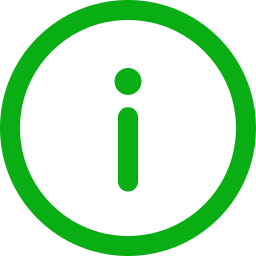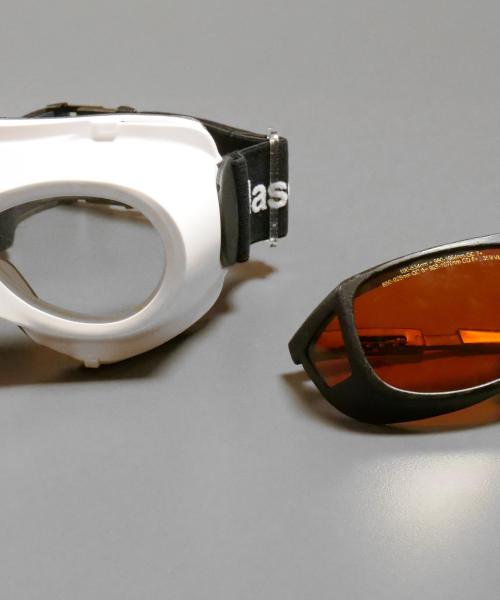Lasers are subject to a rigorous classification system according to their hazard level. This laser class system, established by the IEC (International Electrotechnical Commission), designates a certain number of standards and aims to ensure the safe use of these devices. But what exactly are laser classes, and how do they apply to laser engravers and cutters?
Class 1 lasers
Class 1 lasers are not considered dangerous for two reasons:
- The laser radiation emitted is not powerful enough to cause damage.
- The laser is confined within a secure enclosure, ensuring high safety during use.
While Class 1 lasers can be powerful, they are generally confined within specific enclosures, preventing direct radiation exposure. As a result, the safety of operators and users is guaranteed.
Given this non-exposure at the time of engraving, it is unnecessary to wear safety glasses when handling class 1 lasers.

Class 1M lasers
Class 1M lasers emit visible light in a wavelength range from 302.5 nm to 4,000 nm. When there is no reduction in beam cross-section, these lasers present no danger to the human eye.
Note: Class 1M lasers are commonly used for barcode scanners, notably at supermarket checkouts.

Closed-door laser stations
These Class 1 lasers are designed to meet safety requirements. They can be adapted to any environment: factory, workshop, front and back office...
Maximum safety: the laser cuts out instantly if the door is opened, thanks to a dedicated sensor.
And a viewing window is designed to follow the engraving process.

Lasers that can be integrated into Mini-inline solutions
With this type of laser, a protective sleeve is integrated to ensure safe laser marking. It is placed between the laser marking machine and the workpiece.
The chamber is made of anodized aluminum to isolate the laser beam from the working environment. Safety sensors ensure the presence of the Mini-inline and the part to be marked.
Class 2 lasers

Class 2 and 2M lasers
Class 2
Class 2 lasers emit visible light in the wavelength range from 400 nm to 700 nm, with a power of less than 1 mW.
These lasers, such as the laser pointers used on chalkboards, are considered eye-safe as long as the beam is not viewed for prolonged periods. Please note: the labels and instructions for the use of these lasers indicate that you should not look directly at the source of the beam to avoid any risk.
In normal conditions of use, they are not considered potentially dangerous.
And class 2M...
For Class 2M lasers, used in projectors or laser levels, exposure is not dangerous unless you look directly at the beam.
The safety features are therefore the same, as are the risks.

Gravotech class 2 lasers
Laser engraving and cutting tables
Laser engraving and cutting tables are largely safe thanks to a door that cannot be opened when the device is in operation.
No specific authorization is required to use them.
They can be used in any environment: factory, workshop, front and back office, or store floor.
Class 3 lasers
Class 3 lasers are divided into two distinct sub-categories: class 3R and class 3B (the most dangerous).
These devices are moderately dangerous and can cause injury. Therefore, you must pay close attention to reflective equipment and materials.

Class 3R and 3B lasers
Class 3R lasers
Class 3R lasers have a power of between 1 mW and 5 mW and emit in a wavelength range from 302.5 nm to 10.6 µm. To avoid any risk of eye damage, we strongly advise you to wear protective eyewear.
Class 3B lasers
Class 3B lasers have a power level of between 5 mW and 500 mW. Direct vision into the beam is therefore very dangerous and can cause burns. When using these lasers, protective eyewear must be worn.
Class 4 lasers
Laser class 4 is dangerous in direct or diffuse vision causing damage to the eyes and the skin and presenting a fire hazard. It is imperative to take strict safety precautions when using these lasers.

Safety precautions
- Protective eyewear must be worn by all operators and anyone in the vicinity of the laser.
- Appropriate skin-covering clothing must be worn to prevent burns.
- You must ensure that the work area is free from flammable particles and well-ventilated to minimize the risk of fire.

Exemples of common use
Class 4 lasers are commonly used in a variety of industrial applications:
- laser cutting,
- laser marking,
- laser welding...
These applications demonstrate the efficiency and power of Class 4 lasers while underlining the importance of safety measures to prevent accidents and damage.

Gravotech class 4 marking lasers
Lasers that can be integrated into production lines
These lasers can be used:
- On a column - in which case they must be handled in a secure enclosure, by operators wearing appropriate PPE (Personal Protective Equipment) such as safety goggles.
- On a production line - in which case safety is ensured by integrating the laser. Capable of communicating with PLCs, these machines are primarily designed for this type of use.
Integrable lasers are used for the permanent marking of DPM codes (Datamatrix, Code 1D, Code 2D..) or text.
Class 4, these machines require no additional equipment to operate, except for their integration.

| Warning |
